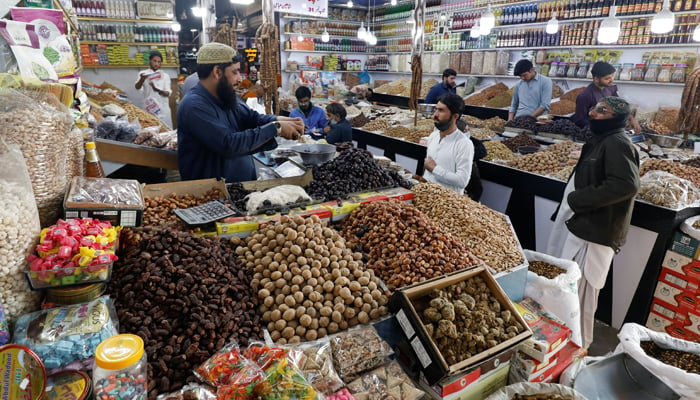[ad_1]

- CPI expected to hover around 29%-31% for September.
- Government’s measures are helping stabilise rupee.
- Agricultural outlook for Kharif 2023 seems promising.
ISLAMABAD: The Ministry of Finance expects an upsurge in inflationary pressures in the coming months in the wake of upward adjustments in energy tariffs, The News reported Friday.
The Consumer Price Index (CPI) based inflation is expected to hover around 29%-31% for September, the ministry stated in its monthly economic outlook.
“The impact of double-digit based effect is a relief to the September inflation; however, its impact seems to have minimized owing to the major increase in fuel price in the month of September 2023.”
“Together with this, the upward adjustment in energy tariffs is further likely to intensify inflationary pressures in the coming months, as these price adjustments are expected to place an additional burden on transportation costs, essential items, and services.”
“In view of the above, inflation is anticipated to remain high in the coming month. In September 2023, it is expected to be around 29 to 31 percent.”
International food prices have been experiencing a decline since August 2023.
The Food and Agriculture Organisation’s (FAO) price index, which tracks the most globally traded food commodities, averaged 121.4 points in August 2023 against 124 for the previous month.
The August figure was the lowest since March 2021 and also 24% below an all-time high in March 2022, in the wake of Russia’s invasion of Ukraine.
The report stated that the decline in most of the food commodities is offsetting the increases in rice and sugar.
Domestically, the government’s stern administrative action against the unlawful foreign exchange dealers and hoarders in commodity markets is stabilising the exchange rate, providing a respite to the imported inflation, and easing out commodity prices.
The SBP has also maintained the policy rate to the previous level in view of anchored inflationary expectations.
Recent administrative measures aimed at improving the availability of essential food commodities and expected ease in supply constraints have improved the inflation outlook.
Moreover, administrative and regulative action for curbing illegal activities in the foreign exchange market have started to yield the desired dividends and narrowing the gap between interbank and open market exchange rates.
“On the external front, current account deficit and aligned indicators are showing some developments in August. Similarly, fiscal performance remains satisfactory at the start of FY2024.”
“It is expected that the economic revival plan and prudent actions — policies including SIFC and IT policy — will attract new investments to create a multiplier effect in the economy for higher and inclusive economic growth in FY2024 and further in the medium term,” the report added.
Agriculture
The agricultural outlook for Kharif 2023 seems promising, as the input demand shows an uptick due to lucrative incentives by the government; however, there may be downside risks due to climate shocks.
The recent pest attack on cotton crops may pose substantial risks to the cotton yield.
Industrial activity
The LSM cycle usually follows the cyclical movements in the main trading partners, but since it is focused on the main industrial sectors and not on total GDP, it is somewhat more volatile than the cyclical component of GDP in Pakistan’s main export markets.
The aggregate CLI in the main export markets continued to remain below the potential level since April 2022.
The cyclical LSM pattern in the month of July showed some improvement though still below the potential level. For the month of August, the pressure is expected to ease out further on the back of significant rebounds in cement dispatches and the removal of import restrictions.
The Monthly Economic Indicators (MEI) estimated for August 2023 stood positive on the back of improved exports and imports on an MoM basis and rising cement dispatches. As the government is striving to revive the economy, the MEI is expected to be positive throughout the outgoing fiscal year.
External sector
August-FY2024, the Balance of Payment (BoP) data shows some developments — as exports of goods and services increased by 13.8 percent on MoM basis, and imports of goods and services increased marginally by 1.4%.
As a result, strong growth in exports has been transmitted in the trade deficit of goods and services which decreased by 12.6% on MoM basis in the month of August.
Similarly, remittances increased by 3.2% in August 2023. All these positive factors impacted the current account and its deficit decreased by around 79% on both MoM and YoY basis.
For the outlook, the recent administrative measures against speculative activity in the foreign exchange market in the month of September will impact positively remittances inflows, trade, and current account balance.
Moreover, Pakistan’s main export markets, particularly the US, the UK, Euro Area, and China’s monthly CLI positions, indicate an upward trend, indicating positive prospects for export growth in the coming months.
However, imports will gradually increase to stimulate economic activities in the economy. Therefore, it is expected that the current account will remain within a sustainable limit.
On the fiscal front, in July FY2024, fiscal performance remained satisfactory while exhibiting a surplus in the primary balance accompanied by a fiscal deficit at the same level as last year.
On the revenue side, new tax measures are contributing to direct tax collection. Other components of tax collection like FED have also posted significant growth mainly due to an uptick in collections at the import stage.
With the removal of import restrictions, collection from import-related taxes is likely to increase further.
[ad_2]
Source link
